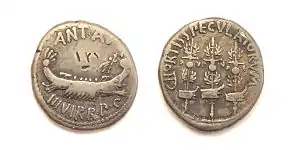Cohort (military unit)
A cohort (from the Latin cohors, plural cohortes, see wikt:cohors for full inflection table) was a standard tactical military unit of a legion, although the standard size changed with time and situation was generally composed of 480 soldiers. A cohort is considered to be the equivalent of a modern military battalion. The cohort replaced the maniple following the reforms attributed to Gaius Marius in 107 BC.[1] Shortly after the military reforms of Marius, and until the middle of the third century AD, ten cohorts (about 5000 men total) made up a Roman legion. The cohorts were named "first cohort", "second cohort" etc. The first cohort consisted of experienced legionaries, while the legionaries in the tenth cohort were less experienced.
 |
| Part of a series on the |
| Military of ancient Rome |
|---|
|
|
| Military organization | ||||||||||||||||||||||||||||||||||||
|---|---|---|---|---|---|---|---|---|---|---|---|---|---|---|---|---|---|---|---|---|---|---|---|---|---|---|---|---|---|---|---|---|---|---|---|---|
 | ||||||||||||||||||||||||||||||||||||
|
||||||||||||||||||||||||||||||||||||
Legionary cohort
Originally, a cohort consisted of six centuriae, each commanded by a centurion assisted by junior officers. At various times prior to the reforms, a century might have a hundred men. The cohort had no permanent commander; during combat, the most experienced centurion of the six commanded the entire cohort. In order of seniority, the six centurions were titled hastatus posterior, hastatus prior, princeps posterior, princeps prior, pilus posterior and pilus prior. The first centurion of the first cohort was called primus pilus.
During the Marian reforms in the 1st century AD, the command structure and make-up of the legions was established in a formal standard. Standard centuriae consisted of eighty men each. The first cohort was made up of five double-strength centuries (160 men). The centurion of its first century automatically was senior in the legion known as the primus pilus. The primus pilus could be promoted to praefectus castrorum, (camp-prefect). The praefectus castrorum was in charge of the daily administration of a legion.
These ranks followed the order of seniority in the earlier manipular legions. Youngest and least experienced units were termed hastati, next principes, and the oldest and most experienced triarii (pilus was a rare alternative name for triarius, the singular of triarii).[2]
The reformed legion numbered about five thousand men, including officers, engineers, and cavalry (equites legionis; 120 men plus horses).[3]
Types of cohort

- Cohors alaria: allied or auxiliary unit
- Cohors quinquagenaria: auxiliary, nominally 500 strong
- Cohors milliaria: auxiliary, nominally 1000 strong
- Cohors classica: auxiliary unit originally formed of sailors and marines
- Cohors equitata (LA): unit of auxiliary infantry with attached mounted squadrons
- Cohors peditata (LA): infantry unit
- Cohors sagittaria: infantry auxiliary unit of bowmen
- Cohors speculatorum (LA): guard unit of Mark Antony composed of scouts
- Cohors torquata (LA): auxiliary unit granted a torques (military decoration)
- Cohors tumultuaria (from tumultus, "chaos"): irregular auxiliary unit
Other Roman cohorts
Although not part of a legion, some paramilitary corps in Rome consisted of one or more cohorts:
- The nine cohortes praetoriae, never grouped to a legion, the infamous Praetorians. The term was first used to refer to the bodyguard of a general during the republic; later, a unit of imperial guards (temporarily restyled cohors palatina (imperial cohort),[4] c. 300 AD, under Diocletian's tetrarchy).
- Cohors togata was a unit of the Praetorian guard in civilian clothes tasked with duties within the pomerium (sacred center of the capital, where all armed forces were forbidden).
- Cohortes urbanae, "urban cohort": Law enforcement officers patrolling in the capital.
- Cohortes vigilum, "watchmen": Law enforcement officers forming the fire brigade in the capital.
- Cohors Germanorum (LA): the unit of Germani custodes corporis (imperial body guards recruited in Germania).
Furthermore, the Latin word cohors was used in a looser way to describe a rather large "company" of people (see, for instance, cohors amicorum).
References
- Nelson, Eric (2001-08-01). The Complete Idiot's Guide to the Roman Empire: Engrossing Stories of Roman Conquest, Palace Intrigue, and the Politics of Empire. Penguin. ISBN 978-1-101-19918-3.
- http://www.treccani.it/enciclopedia/primipilo/
- Goldsworthy, Adrian (2003). The Complete Roman Army. London: Thames & Hudson Ltd. ISBN 0-500-05124-0.
- "Hence adj. Pălātīnus -a -um Palatine; Apollo, whose temple was on the Palatine, Hor.; also relating to the imperial palace, imperial: Ov."—Simpson, D. P. (1968). Cassell's Latin Dictionary (5th ed.). New York: Macmillan General Reference. p. 420. ISBN 0-02-522570-7.
External links
| Wikimedia Commons has media related to Ancient Roman cohortes. |